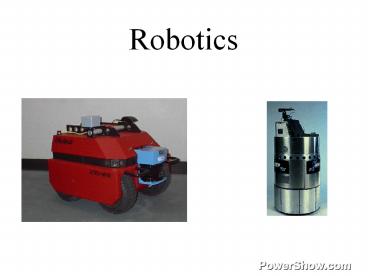Robotics - PowerPoint PPT Presentation
Title:
Robotics
Description:
Robotics. Robots. Mobile. Humanoid. Legged. Industrial. Sensors. Range. Sonar, Sick LMS, Infrared ... Landmark-based Use environment to localize. Metric ... – PowerPoint PPT presentation
Number of Views:230
Avg rating:3.0/5.0
Title: Robotics
1
Robotics
2
Robots
- Mobile
- Humanoid
- Legged
- Industrial
3
Sensors
- Range
- Sonar, Sick LMS, Infrared
- Inertial
- Accelerometers, Gyroscopes
- Odometry
- Shaft Encoders
- Imaging
- Camera
- GPS
4
Actuators
- Robot interaction with the world
- Motors
- Arms
- Degrees of Freedom
- Number of independent directions an actuator can
move
5
Robot Localization
- Landmark-based Use environment to localize
- Metric-based Use robot motion to localize
- Better to use both, typically probabilistic
- Transition (Motion) model
- Sensor model
6
Robot Localization
- Kalman Filters
- Represent robot position as Guassian
- After moving, update robot position using motion
model - Update robot position using sensor model based on
observation - Disadvantage Unimodal representation
Robot Position
Landmark
7
Robot Localization
- POMDPs
- Represent world as POMDP
- Maintain robot position as belief state
- Update belief state after movement based on
motion model - Obtain observation
- Update belief state based on sensor model
- Advantages
- Multimodal representation
- Can be used for planning
- Disadvantages
- Requires discretization of environment
- Computationally expensive
8
Robot Localization
- Monte Carlo Localization
- Uses Particle Filters
- Keep random set of possible positions
- Update each sample based on motion and
observation - Select weighted sub-sample from new set
- http//www.cs.washington.edu/ai/Mobile_Robotics/mc
l/ - Advantages
- Can handle continuous spaces
- Not computationally expensive
9
Mapping
- Evidence Grids Weighted map representation
- Updated based on sensor models
- SLAM Simultaneous localization and mapping
- Robot needs to build map and localize at same
time - FastSLAM
- Uses same mechanism as MCL.
- Each sample maintains map.
- http//www.informatik.uni-freiburg.de/haehnel/res
earch/scan-matching-fastslam
10
Obstacle Avoidance
- Schema-based navigation
- Robot attracted to goal
- Robot repelled from obstacles
- Weighted sum up vectors gives resulting vector
- Generalizable to other behaviors
- GoToBall, Wander, FollowHallway, EnterDoor
- Extremely fast to calculate
- Problems with local minima
11
Architectures
- Robots contain several components which need to
fit together - Handle high level and low level control
- Sensing, acting, mapping, localizing, planning,
- Need to be able to react quickly
12
Reactive Systems
- Tight coupling between sensing and action
- No world state
- Sometimes represented as FSA
13
Three Layer Architecture
- Hybrid architecture
- Combines high level deliberation with low level
control - Reactive Layer low level controls of robot (ex
schemas) - Executive Layer accepts actions from
deliberative layer and sequences actions for the
reactive layer - Deliberative Layer handles complex tasks such
as planning
14
More Robots































